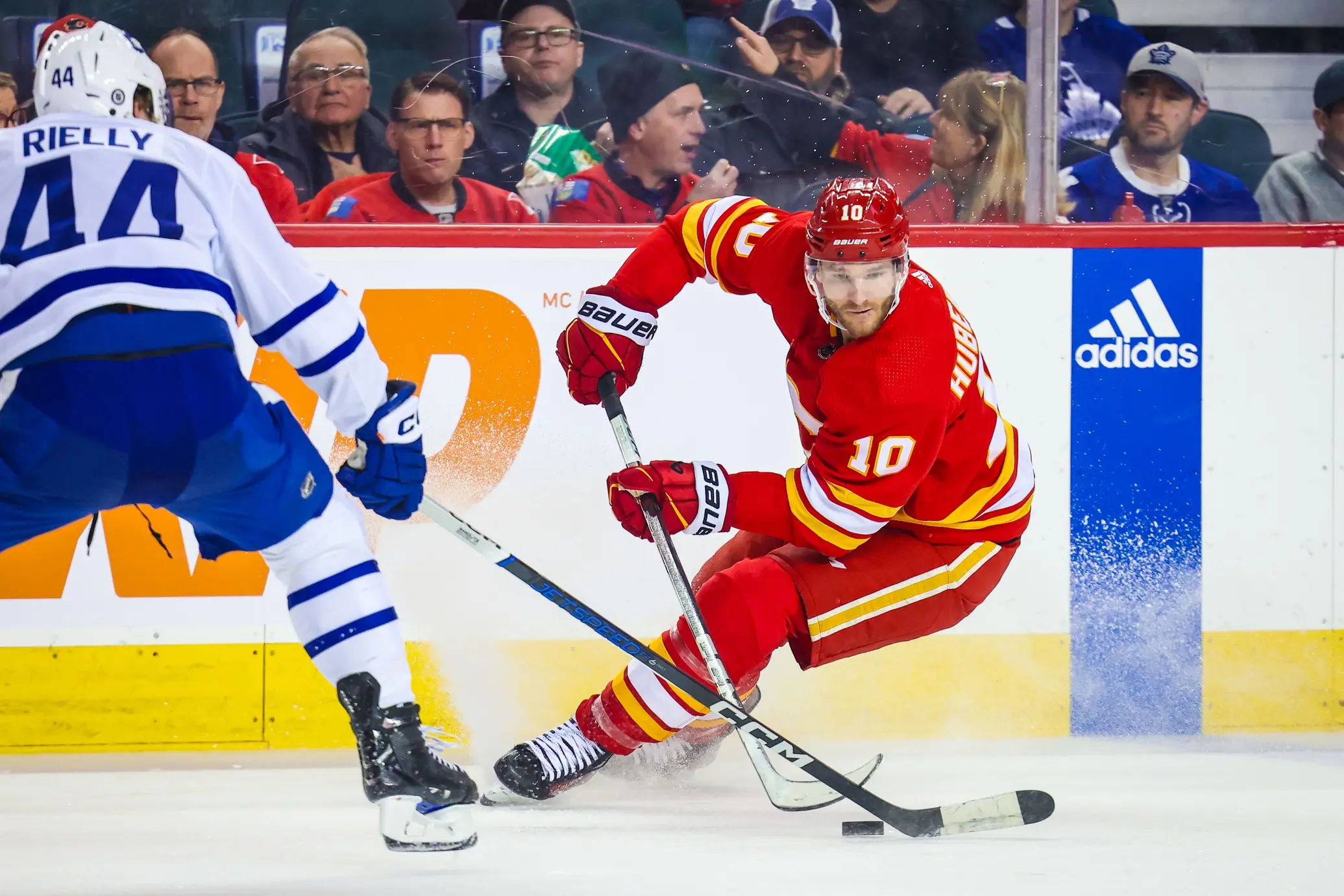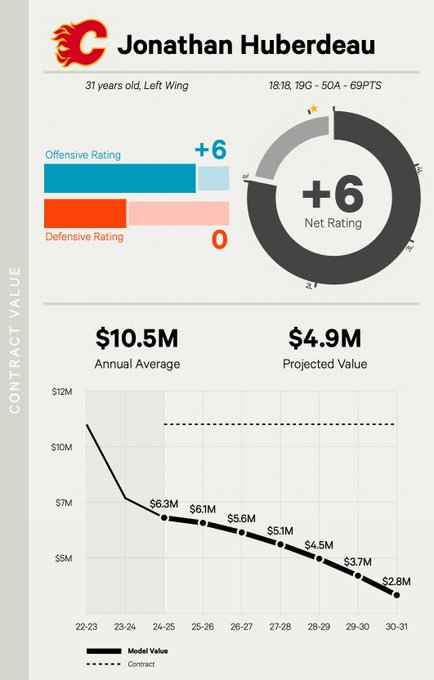From Jonathan Huberdeau to Darnell Nurse — my annual look at the 10 worst contracts in hockey. nytimes.com/athletic/56324…
Nation Sites
The Nation Network
FlamesNation has no direct affiliation to the Calgary Flames, Calgary Sports and Entertainment, NHL, or NHLPA
Jonathan Huberdeau has the NHL’s worst-value contract, according to The Athletic

Photo credit: Sergei Belski-USA TODAY Sports
Be sure to check out the latest odds with online sportsbook Betway.
The Calgary Flames acquired Jonathan Huberdeau from the Florida Panthers just shy of two years ago. A couple weeks later, they signed Huberdeau to the largest contract in franchise history, an eight year deal worth $84 million to begin in 2023-24.
Coming off a monster season with the Panthers in 2021-22, Huberdeau seemed like a smart bet for a Flames club hoping to stay in the playoff hunt. But things haven’t gone swimmingly for Huberdeau in Calgary so far.
In their yearly rundown of the best and worst value contracts in the National Hockey League, the Athletic’s Dom Luszczyszyn listed Huberdeau’s deal as the worst-value pact in the circuit.
Here’s a snippet from Luszczyszyn’s analysis:
Jonathan Huberdeau has the worst contract in hockey. You know it. I know it. He knows it. He’s making franchise forward money for seven more seasons despite scoring like a second-liner in back-to-back seasons. There’s no use belaboring the point further — the question is whether he can do anything to get back on track.
(Stick-taps for him working “belaboring” into his analysis, it’s a fantastic word. The Athletic’s behind a paywall, so go over there and dive in for the whole rundown on Huberdeau’s deal, which was interestingly upbeat.)

First, folks, a disclaimer: nobody is saying that Huberdeau is bad at hockey. What Luszczyszyn’s analysis looks at it player performance – actual and projected – in comparison to the value of each player’s contract. Huberdeau carries a $10.5 million cap hit for another seven seasons, and it’s probably not controversial to say that his on-ice performance hasn’t produced $10.5 million in value.
Huberdeau was acquired by the Flames following a season where he had 30 goals, 85 assists and 115 points – he set a single-season record that year for assists by a left winger – and he was playing in a system in Florida that really was well-suited to his strengths.
- The Panthers were a high shot volume team, leading the NHL with 37.3 shots per game.
- The Panthers had a strong power play, converting on 24.4% of their advantages (5th in the NHL) and scoring 64 goals on the man advantage (3rd in the NHL).
- The Panthers led the NHL in five-on-five goals and all-situations goals.
The Panthers were a team whose attack was designed around run-and-gun, with a cast well-suited to that style. So when Huberdeau came to Calgary, he had to adjust to a lot of changes – both personal and stylistic. When you’ve been able to have success playing a certain style – and few in NHL history had as much success in that type of system as Huberdeau did – it’s tough to flip a switch and change your game.
In his last season in Florida, Huberdeau had 115 points. In two seasons in Calgary combined, he’s had 107 points. Are there reasons for optimism? Well, a few. (Unless noted, we’re cribbing stats from our pals at Natural Stat Trick.)
- Huberdeau’s 5v5 individual expected goals have jumped from 10.52 in 2022-23 to 11.92 in 2023-24. (It’s a far cry from 14.55 in 2021-22, but he’s trending up.) His 5v5 shots per game have also jumped from 5.01 in 2022-23 to 5.63 in 2023-24. (Again, way down from 8.09 per game in Florida, but trending up.)
- While a decent amount of his production decline can be attributed to him not performing as well as he did in Florida, some evidence also points to some tough puck luck. Huberdeau’s 5v5 personal shooting percentage – the proportion of his shots that went in – dropped from 12.5% in 2021-22 to 11.63% in 2022-23 to 6.73% in 2023-24. And his on-ice shooting percentage – the proportion of all shots that go in when he’s on the ice – went from 10.12% in 2021-22 to 8.7% in 2022-23 to 7.0% in 2023-24.
Huberdeau is the owner of a pretty ugly NHL record: the largest single-season drop-off in points between two seasons, with a 60-point gap between 2021-22 and 2022-23. But when you factor in the move from Sunrise to Calgary and all the things it entailed off the ice, then the gigantic systemic differences between the Panthers and Flames, and then factor in the varying qualities of supporting casts in each outfit – and the challenges the Flames had on the power play in Huberdeau’s first two seasons in Alberta – yeah, you can kind of wrap your head around why it wasn’t quite clicking for him.
It is worth noting, as we have during the past year, that Huberdeau seemed much more impactful for the Flames once the calendar flipped over to 2024.
- From Oct. 1 to Dec. 31: 4 goals, 12 assists, 16 points in 36 games, 50.69% xGF (5v5), 6.77% on-ice shooting percentage (5v5), 7.14% personal shooting percentage (5v5), 0.31 average game score
- From Jan. 1 to Apr. 18: 8 goals, 28 assists, 36 points in 45 games, 51.46% xGF (5v5), 7.19% on-ice shooting percentage (5v5), 6.45% personal shooting percentage (5v5), 0.66 average game score
It wasn’t like Huberdeau’s personal or on-ice shooting percentage shot up a crazy amount, but his underlyings remained steady and he started to do more interesting, exciting stuff with the puck. It also helps that the power play started to wake up, in part due to Andrei Kuzmenko’s arrival and subsequent injection of swagger into the man advantage groups.
In short: yeah, it’s probably not unfair to gesture towards Huberdeau’s contract and wince a little bit. But we’re going to invoke the Matt Stajan Principle: we’re not about to blame a player for signing a deal that was offered to him, and without parroting Luszczyszyn’s analysis (it’s worth reading for yourself), we don’t disagree with the premise that there are reasons to be optimistic about Huberdeau’s game and production possibly being on an upward trend.
Breaking News
- Flames Game Day 35: Visitors from the Emerald City (7pm MT, SN1)
- Flames trade rumours: The Wild like Nazem Kadri as a trade option
- Which Flames prospects might be going pro in 2026-27?
- What should the Flames defensive pairings look like when Zayne Parekh returns from the World Juniors?
- Flames Prospect Roundup: Jacob Battaglia had a four-point night

